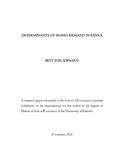| dc.description.abstract | Understanding the demand for money in an economy is an important
prerequisite for formulating and conducting monetary policy. The demand
for money is mainly influenced by the levels of prices, interest rates, real
national output and the pace of financial innovation.
Kenya has undergone significant changes in the macroeconomic landscape
over the years such as financial liberalization, exchange rate regime
changes, liberalization of the capital account of the balance of payment and
an array of financial innovations and developments. Such changes in the
economy may have caused shifts in the parameters of the money demand
function over time, making the function unreliable for policy decisions. It is
therefore necessary to investigate the money demand function in the
country using the latest data and including financial innovation.
Studies in Kenya have not included in the money demand estimations the
role of financial innovations witnessed in the country since the financial
liberalization of 1980s and 1990s. This study measured and included
financial innovations in the money demand function as well as captured the
impact of financial liberalization since it used data for pre and post
liberalization.
Most of the empirical studies reviewed expressed the money demand
functions in real terms and specified the models as log-linear with the
estimation relying mainly on error correction models. The contemporary
studies acknowledged the role of changing external and internal economic
and financial landscape, as well as the achievements in the time series
econometric estimation of money demand functions.
Using cointegration and error-correction model, this study sought to
examine the relationship between demand for money and levels of prices,
interest rates, real national output, exchange rate and the pace of financial
innovation in Kenya using data from 1970 to 2012
The short-run and long-run estimation findings show that only GDP, and
inflation are significant determinants of real money demand in Kenya.
Specifically, the results show that increased GDP and inflation increases the
demand for real money balances. This implies that policies aimed at
increasing the country’s GDP should be pursued. Also since money
demand is determined by inflationary factors in Kenya, it supports the use
of monetary aggregates M3 to target inflation as a policy tool. | en_US |

